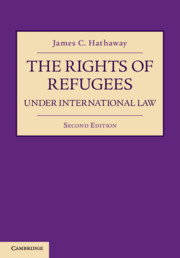Book contents
- The Rights of Refugees under International Law
- The Rights of Refugees under International Law
- Copyright page
- Dedication
- Epigraph
- Contents
- Table of Concordance to the Refugee Convention and Protocol
- Acknowledgments
- Table of Cases
- Table of Treaties and Other International Instruments
- Abbreviations for Courts and Tribunals Cited
- Introduction
- 1 The Evolution of the Refugee Rights Regime
- 2 An Interactive Approach to Interpreting Refugee Rights
- 3 The Structure of Entitlement under the Refugee Convention
- 4 Rights of Refugees Physically Present
- 5 Rights of Refugees Lawfully or Habitually Present
- 6 Rights of Refugees Lawfully Staying
- 7 Rights of Solution
- Book part
- Select Bibliography
- Index
Introduction
Published online by Cambridge University Press: 10 March 2021
- The Rights of Refugees under International Law
- The Rights of Refugees under International Law
- Copyright page
- Dedication
- Epigraph
- Contents
- Table of Concordance to the Refugee Convention and Protocol
- Acknowledgments
- Table of Cases
- Table of Treaties and Other International Instruments
- Abbreviations for Courts and Tribunals Cited
- Introduction
- 1 The Evolution of the Refugee Rights Regime
- 2 An Interactive Approach to Interpreting Refugee Rights
- 3 The Structure of Entitlement under the Refugee Convention
- 4 Rights of Refugees Physically Present
- 5 Rights of Refugees Lawfully or Habitually Present
- 6 Rights of Refugees Lawfully Staying
- 7 Rights of Solution
- Book part
- Select Bibliography
- Index
Summary
This analytical gap can be explained at least in part by reference to the tradition of most developed states simply to admit refugees, formally or in practice, as long-term or permanent residents. While not required by the Refugee Convention,2 this approach led de facto to respect for most Convention rights (and often more). Because refugee rights were not at risk, there was understandably little perceived need to elaborate their meaning.
Today, however, governments of the industrialized world increasingly question the logic of routinely assimilating refugees, and have therefore sought to limit their access to Convention rights. Most commonly, questions are now raised about whether refugees should be allowed to enjoy freedom of movement, to work, to access public welfare programs, or to be reunited with family members.
- Type
- Chapter
- Information
- The Rights of Refugees under International Law , pp. 1 - 9Publisher: Cambridge University PressPrint publication year: 2021

